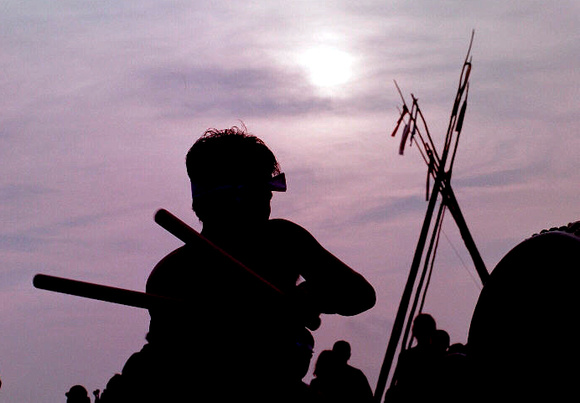0145: Shinji Shumeikai Taiko Drummer
Shinji Shumeikai is a Japanese-based spiritual fellowship dedicated to the enhancement of life.
The exact history of Japanese Taiko drum remains shrouded in speculation, although some educated guesses are possible. The oldest physical evidence of taiko in Japan is a haniwa clay figure of a drummer that dates from the sixth or seventh century. However, since the first instruments in any society tend to be percussion instruments, it would not be out of the question for taiko (as we know them today) to have been used in Japan for well over 2000 years.
Japanese taiko as we know them today bear strong resemblance to Chinese and Korean instruments, which were probably introduced in the waves of Korean and Chinese cultural influence from 300-900 AD. It has been speculated that the predecessor of the tsuzumi style of taiko may come from as far as India, and came to Japan along with Buddhism. However, the waves of cultural influence stopped for the most part around the year 900, and development from that point can basically be attributed to native Japanese craftsmen. Taiko, although continuing to bear similarities to Chinese and Korean drums, have evolved into unique Japanese instruments.
Reputedly, one of the first uses of taiko was as a battlefield instrument; used to intimidate and scare the enemy - a use to which drums have been put in many cultures. Taiko were definitely used in battle to issue commands and coordinate movements by the 1500's; the taiko being the only instrument that could be heard across the entire battlefield. According to picture scrolls and painted screens of the time, one soldier would carry the taiko lashed to a backpack-like frame, while two other soldiers would beat the taiko, on each side. Both nagado and okedo style taiko were used in this capacity. A war taiko used by Shingen Takeda, a famous warlord of that era, still exists and is preserved by Osuwa-daiko. It is remarkable for the three large holes cut in the side of the nagado style taiko. This served to increase the volume of the drum, useful in battle.
In addition to the martial aspect, taiko have always been used in the most refined cultural settings as well. Gagaku music was introduced to Japan in the Nara periord (697-794) along with Buddhism, and was quickly adopted as the imperial court music. Gagaku is the oldest continually played court music in the world, and it is still being performed. The taiko used for Gagaku (kakko, san-no-tsuzumi, dadaiko, tsuri-daiko, ninai-daiko, ikko, furitsuzumi, kaiko) are some of the most elegant and beautifully decorated of all Japanese instruments.
The rumbling power of the taiko has also been long been associated with the gods, and has been appropriated by the religions of Japan.


